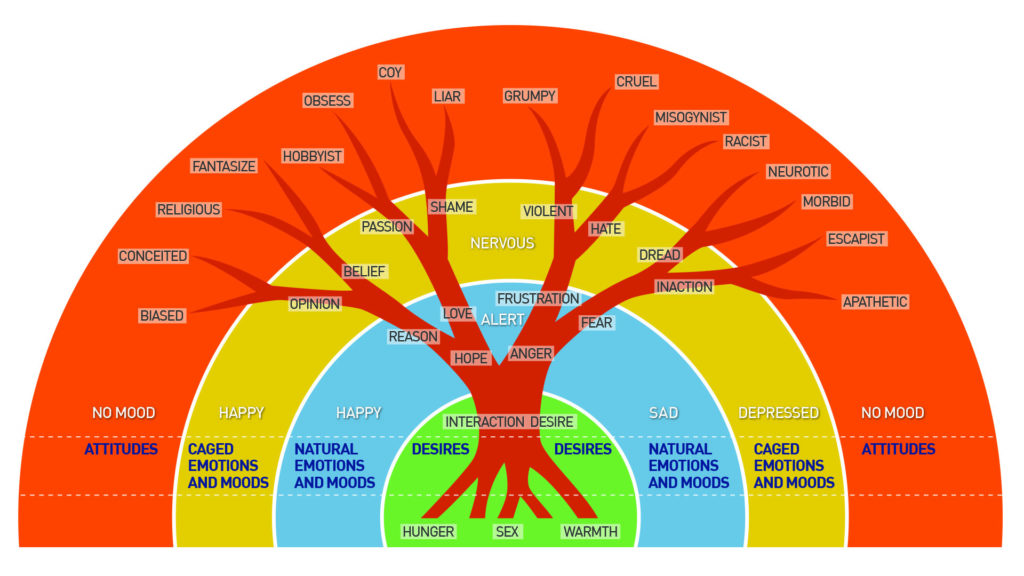
“Keys to Emotional Intelligence in Organizations”
The Meeting Guy supports corporate teams, nonprofit organizations, and intentional communities.
Tool: Emotional Intelligence
Proficiency with emotional intelligence (EI) is an effective predictor for improving workplace performance.
EI indicates the emotional, personal, social, and survival dimensions of individuals and groups, and can be easily measured throughout your entire organization.
Organizational and cultural capacity to meet environmental demands and pressures, while being responsible and sensitive to staff, vendors and customers, can be improved by devoting time and resources to growing your EI skills base.
As people become more emotionally intelligent, they grow their ability to successfully and efficiently cope with change and accomplish goals.
EI proficiency can reflect people’s feelings about the mission of their community, the work they do, including their capacity to work effectively with their land-mates, coworkers, leadership, and the organization itself.
Emotionally intelligent organizations are productive places to work because they:
1.
Hire capable people who love what they do
2. Compensate people fairly
3. Distribute workload equitably
4. Build strong teams with shared purpose and viable goals
5. Ensures leaders and managers have effective management tools
6. Respect unique individuals while helping leverage unique talents
7. Proactively access the hearts and minds of their people
A major advantage of Emotionally Intelligent organizations is the way individuals proactively optimize value for everyone involved. Unlike cognitive intelligence, emotional intelligence competencies can be improved through training. Most importantly, they are fun to learn!
E.I. Exercise #1: “Open The Doorway To Workplace Emotions”
Objective:
Create safety, indicate your current state, practice using emotion-words
Materials:
All you need for this simple exercise are 3×5 cards.
Setup:
Explain that it is beneficial to be familiar the range of possible workplace emotions, so you can be more aware of how you are feeling, and how your co-workers are feeling. – – – Then, you can take steps to change the way you feel.
Exercise:
Distribute several blank 3×5 cards
Each person identifies up to 5 emotions, and writes down one emotion per card.
(Spread them face-up around the table to avoid duplicates)
Now turn all the cards face-down, mix up and each person chooses 2.
In order, each person explains to the group the conditions, situation, or what it takes to arrive at that emotional state. If a negative emotion, also explain what it takes to move back towards a positive state.
Debrief conversation to close: How does this relate to your world of work?
Example Emotions:

The Meeting Guy helps leaders identify “blind spots” in their organizations.
We help you develop commitments and strategies for growth and development, apply action steps, measure, assess, and adjust for optimal performance.
Your organization certainly has intelligent, highly educated people. Just as certainly, that’s not enough. With intelligent design, you can promote an effective EI culture, and improve your success.
Who is The Meeting Guy?
The Meeting Guy coaches top executives. We also facilitate meetings, team building, and strategic retreats for nonprofit Boards, sales teams, ecovillages, and public interest groups.
We work with agencies and support their work with multi-stakeholders groups. The Meeting Guy has planned retreats and facilitated meetings across the USA, and helped lead team building programs for Fortune 500 companies on two continents.
Please see: www.themeetingguy.com for more information.
“Excellent meetings, happy people.”
The Meeting Guy is also the real-life Superhero leader of Superhero Team Training (www.superhero-training.com).
Contact us now!

“Keys to Emotional Intelligence in Organizations”
The Meeting Guy supports corporate teams, nonprofit organizations, and intentional communities.
Tool: Emotional Intelligence
Proficiency with emotional intelligence (EI) is an effective predictor for improving workplace performance.
EI indicates the emotional, personal, social, and survival dimensions of individuals and groups, and can be easily measured throughout your entire organization.
Organizational and cultural capacity to meet environmental demands and pressures, while being responsible and sensitive to staff, vendors and customers, can be improved by devoting time and resources to growing your EI skills base.
As people become more emotionally intelligent, they grow their ability to successfully and efficiently cope with change and accomplish goals.
EI proficiency can reflect people’s feelings about the mission of their community, the work they do, including their capacity to work effectively with their land-mates, coworkers, leadership, and the organization itself.
Emotionally intelligent organizations are productive places to work because they:
1.
Hire capable people who love what they do
2. Compensate people fairly
3. Distribute workload equitably
4. Build strong teams with shared purpose and viable goals
5. Ensures leaders and managers have effective management tools
6. Respect unique individuals while helping leverage unique talents
7. Proactively access the hearts and minds of their people
A major advantage of Emotionally Intelligent organizations is the way individuals proactively optimize value for everyone involved. Unlike cognitive intelligence, emotional intelligence competencies can be improved through training. Most importantly, they are fun to learn!
E.I. Exercise #1: “Open The Doorway To Workplace Emotions”
Objective:
Create safety, indicate your current state, practice using emotion-words
Materials:
All you need for this simple exercise are 3×5 cards.
Setup:
Explain that it is beneficial to be familiar the range of possible workplace emotions, so you can be more aware of how you are feeling, and how your co-workers are feeling. – – – Then, you can take steps to change the way you feel.
Exercise:
Distribute several blank 3×5 cards
Each person identifies up to 5 emotions, and writes down one emotion per card.
(Spread them face-up around the table to avoid duplicates)
Now turn all the cards face-down, mix up and each person chooses 2.
In order, each person explains to the group the conditions, situation, or what it takes to arrive at that emotional state. If a negative emotion, also explain what it takes to move back towards a positive state.
Debrief conversation to close: How does this relate to your world of work?
Example Emotions:

The Meeting Guy helps leaders identify “blind spots” in their organizations.
We help you develop commitments and strategies for growth and development, apply action steps, measure, assess, and adjust for optimal performance.
Your organization certainly has intelligent, highly educated people. Just as certainly, that’s not enough. With intelligent design, you can promote an effective EI culture, and improve your success.
Who is The Meeting Guy?
The Meeting Guy coaches top executives. We also facilitate meetings, team building, and strategic retreats for nonprofit Boards, sales teams, ecovillages, and public interest groups.
We work with agencies and support their work with multi-stakeholders groups. The Meeting Guy has planned retreats and facilitated meetings across the USA, and helped lead team building programs for Fortune 500 companies on two continents.
Please see: www.themeetingguy.com for more information.
“Excellent meetings, happy people.”
The Meeting Guy is also the real-life Superhero leader of Superhero Team Training (www.superhero-training.com).
Contact us now!
